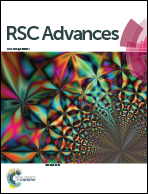Photo tuning of thiophene-2,5-dicarbohydrazide derivatives for their photoalignment ability-molecular modelling studies†
Abstract
In this work, we reported a photoalignment of a nematic liquid crystal, promoted by thin alignment layers made from novel thiophene-2,5-dicarbohydrazide derivatives after being illuminated with linear polarized UV light. A clear indication of the relationship between the molecular structure and alignment properties of the materials was obtained by introducing a methyl substituent group (–CH3) in the molecular structure of some of the materials studied in this work. Interestingly, the illumination with linear polarized UV caused the preferred direction of liquid crystal alignment, promoted by these layers, to be oriented either parallel (in the case of the thiophene derivative without methyl substitution) or perpendicular (in the case of the thiophene derivative with methyl substitution). The mechanism behind the observed alignment effect is elucidated by molecular modelling studies. These studies suggested the change of the orientation of the molecular net dipole moment, when a methyl group is incorporated in the molecular structure of the materials, as a possible origin. Such information is indispensable for the design and synthesis of novel photo-alignment materials for liquid crystal displays of high quality.


 Please wait while we load your content...
Please wait while we load your content...